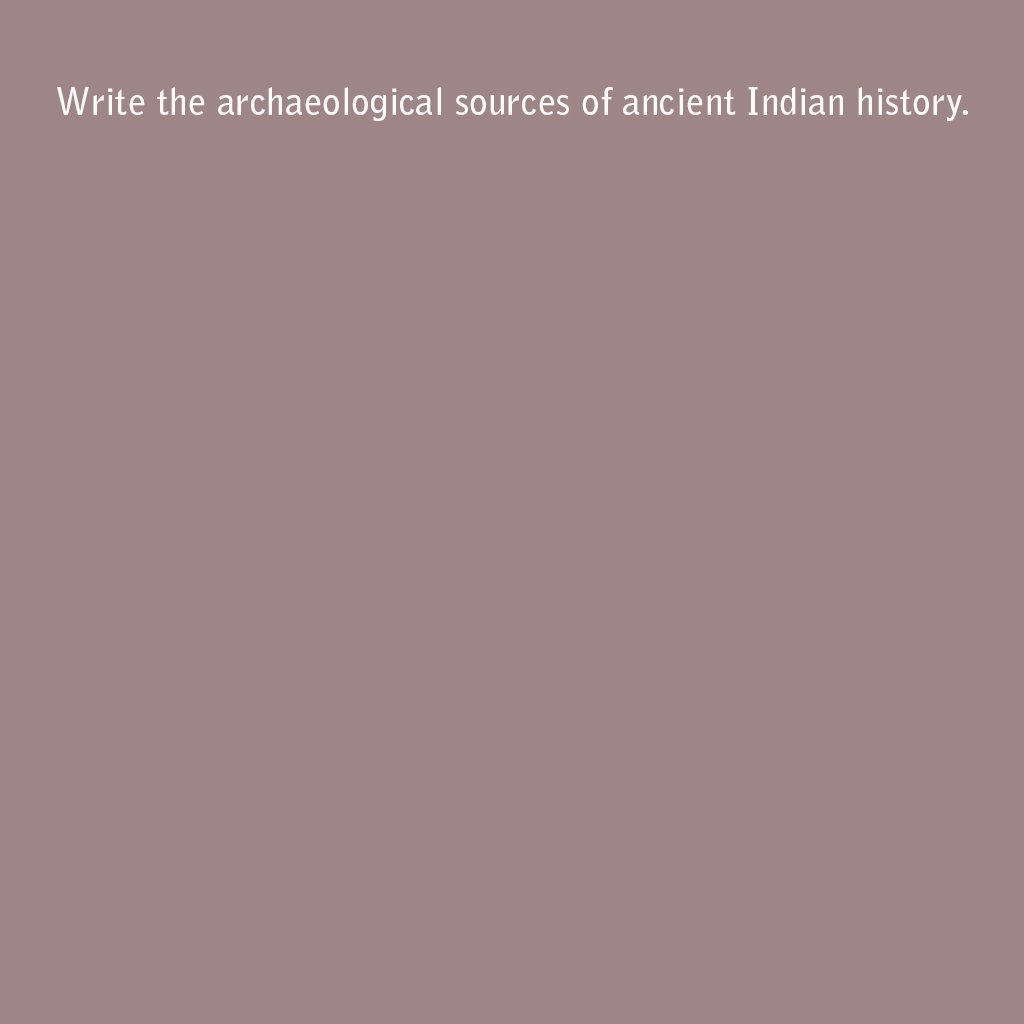archaeological sources of india
Must Read From Start to Finish
Introduction
For the study of Ancient Indian History, we have various types of sources available. These sources are mainly divided into two categories:
-
Literary Sources
-
Non-Literary or Archaeological Sources
While literary sources include the Vedas, Puranas, Ramayana, Mahabharata, Jain and Buddhist texts, and foreign travelers’ accounts, archaeological sources are the evidences obtained from beneath or above the earth. Based on these, we get knowledge about ancient life, culture, society, and governance.
The word Archaeology is formed from ‘Pura’ (Ancient) and ‘Tatva’ (Element or Object). Therefore, Archaeology refers to the study of ancient objects.
The history of India spans thousands of years, and its accurate assessment is possible only when we deeply analyze the available archaeological evidence.
Need and Importance of Archaeological Sources
-
Most ancient literary sources are filled with mythology and exaggeration.
-
Many historical events are not mentioned in literary records but are confirmed by archaeological evidence.
-
For accurate knowledge of different cultures, civilizations, and societies, archaeological sources are indispensable.
-
Archaeological sources provide us with factual information about livelihood, lifestyle, religion, art, architecture, wars, governance, etc.
Main Archaeological Sources of Ancient Indian History
1. Remains and Excavations
(a) Indus Valley Civilization Remains
-
Mohenjo-Daro, Harappa, Kalibangan, Lothal, Rakhigarhi – From these sites, we get city planning, the Great Bath, granaries, buildings, drainage systems, pottery, sculptures, ornaments, seals, tools, etc., which reflect the advanced culture of the Indus Valley Civilization.
-
The civilization dates back to 2500 BCE to 1500 BCE.
-
The Great Bath of Mohenjo-Daro is an excellent example of ancient water management.
-
Excavations reveal information about agriculture, trade, religion, and social systems.
(b) Vedic and Post-Vedic Period Remains
-
Archaeological evidence from the Vedic period is limited, but post-Vedic remains include iron tools, Yupa pillars, and pottery.
-
The Painted Grey Ware (PGW) culture belongs to this period.
(c) Mahajanapada and Mauryan Period Remains
-
Settlements, city layouts, forts, terracotta and stone coins, ornaments, and buildings.
-
Mauryan pillars and walls found in Pataliputra (now Patna).
(d) Kushan and Gupta Period Remains
-
Beautiful examples of Buddhist sculpture from Mathura and Gandhara.
-
Development of temple architecture in the Gupta period.
2. Monuments and Architecture
(a) Stupas
-
Buddhist monuments such as the Sanchi Stupa, Bharhut Stupa, and Amravati Stupa.
-
The carvings on these stupas provide information about religious and social life.
(b) Chaityas and Viharas
-
Caves of Ajanta, Ellora, Nasik, Kanheri.
-
These were places of residence and worship for Buddhist monks.
-
Their walls contain paintings and sculptures of great historical value.
(c) Temples
-
Early temples such as the Dashavatara Temple (Deogarh) and the temples of Bhitari village.
-
The Kailashnath Temple at Ellora is a remarkable example of rock-cut architecture.
(d) Forts and Cities
-
Forts and cities built by kings, such as Kashi, Ujjain, Pataliputra.
-
Provide insights into city planning and defense systems.
3. Sculpture and Painting
(a) Indus Valley Sculpture
-
The bronze statue of the Dancing Girl and the priest-king figurine.
-
A seal depicting Pashupati Shiva in a yogic posture.
(b) Mauryan Sculpture
-
Ashoka’s Lion Capital, Lauriya Nandangarh Stupa.
-
Sculptures of Yaksha and Yakshini.
(c) Gandhara and Mathura Style
-
Development of these styles with the spread of Buddhism.
-
Greek influence is visible in Gandhara art.
(d) Gupta Period Sculpture
-
Highly refined sculptures of Buddha, Vishnu, and Shiva.
-
The paintings in the Ajanta Caves are a brilliant example of ancient Indian art.
4. Inscriptions and Epigraphy
(a) Ashokan Inscriptions
-
The most important epigraphic evidence of ancient India.
-
Written in Brahmi and Kharosthi scripts.
-
Provide information about Dhamma policy, social reforms, and administration.
(b) Hathigumpha and Nanaghat Inscriptions
-
Evidence of the worship of Kartikeya.
-
Reveal economic, religious, and social conditions.
(c) Allahabad Pillar Inscription
-
The Prayag Prashasti of Emperor Samudragupta.
-
Describes wars, victories, donations, and achievements.
(d) Inscriptions of Harsha
-
Along with Banabhatta’s Harshacharita, inscriptions of Harsha have been found. archaeological sources of india
5. Coins and Numismatics
(a) Ancient Coins
-
Punch-marked coins used during the Mahajanapada period.
-
Made of gold, silver, copper, lead, etc.
(b) Greek and Shaka Coins
-
Coins of Greek and Shaka rulers bear their images and names.
-
Bilingual coins (in Greek and Kharosthi scripts) are also found.
(c) Kushan Coins
-
Kushan king Kanishka’s coins depict Buddhist and Iranian deities.
-
Provide information on religion, art, and economy.
(d) Gupta Coins
-
Reflect excellent artistry.
-
Coins of Chandragupta II feature Garuda Dhwaja and Goddess Lakshmi. archaeological sources of india
6. Pottery and Tools
-
Beautiful pottery of the Harappan civilization.
-
Painted Grey Ware (PGW) and Northern Black Polished Ware (NBPW) pottery.
-
Tools and weapons made of iron, copper, and bronze.
7. Burials, Tombs, and Human Remains
-
Various burial practices in the Indus Valley Civilization.
-
Analysis of human skeletons gives insights into diseases, diet, and lifestyle of ancient times. archaeological sources of india
Famous Archaeological Sources of Ancient Indian History
Conclusion
Archaeological sources are key to understanding Ancient Indian History. They reveal facts that are not possible to know from literary sources alone.
Through excavations, architecture, sculpture, inscriptions, coins, pottery, and burial remains, it is possible to delve into the depths of history.
The study of these sources not only provides knowledge of the past but also gives us the opportunity to take pride in our cultural heritage. The diverse civilizations and cultures of India come to light through these very sources.
